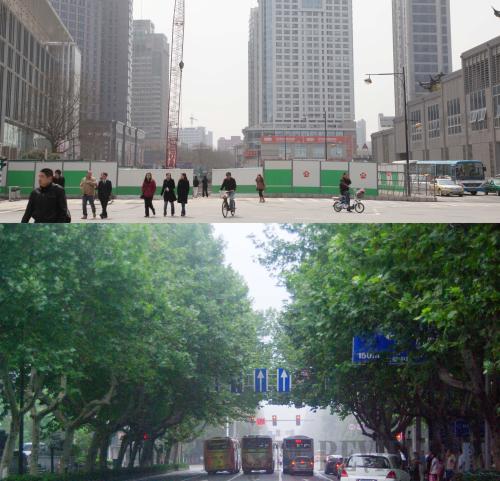|
 |
|
SHARP CONTRAST: The subway construction site on North Taiping Road in Nanjing was once covered in luxuriant greenery (CFP) |
The tall trees in Nanjing, capital city of east China's Jiangsu Province, are an amenity local people boast about. In 1928, in order to commemorate Sun Yat-sen, founder of the Kuomintang, hundreds of plane trees were planted along major streets in the city. Several decades later, these trees have grown into 20-meter-high giants. In summer days, boulevards covered by dense green foliage are cool for everyone coming and going.
On March 9, a start was made on removing more than 40 of these trees along North Taiping Road. In order to make way for subways, around 600 trees nearby are to be removed from streets, including more than 200 plane trees planted during 1952 and 1953.
The first trees to be removed were pruned of branches in late February. Meanwhile, photos of the roots of the toppled trees spread rapidly on the Internet, followed by appeals to "save Nanjing's plane trees." The involvement of celebrities made the issue a heated topic. Locals went out on to the streets at night to tie green ribbons around plane trees scheduled for the axe.
Actually, it is not the first time that trees are removed for civil engineering. In 2006, 83 plane trees were also moved to enable construction of a subway line. On March 12 this year, local media reported, of the 83 plane trees removed five years ago, only 15 managed to survive.
In response to public opposition, the local authority said the construction of subway lines made the removal of plane trees a forced choice. In August 2010, subway departments said at least 2,600 trees should be removed but, after consultation, the number was cut to 1,100.
However, the local government recently said future urban development and construction planning should first consider the protection of ancient trees and they will not be allowed to be cut down. If old trees have to be removed, there must be a strict approval procedure based on an extensive survey of public opinion.
Rapid urban development is increasing conflict between construction and protection. On websites like www.ditiezu.com, quite a number of people did support tree removal. They think tree removal at station points is acceptable and necessary, as long as there is not massive removal along the whole subway line. Meanwhile, major media around the country are filling space with discussions on how urban construction may possibly proceed hand in hand with historical and cultural protection.
Xu Shaolin (www.xinhua.com): From the perspective of management, we don't want any tree removed, but this is unrealistic. Subway construction is a systematic project. A subway line has many station points and every station has four outlets. Therefore, tree removal is unavoidable.
What the authority can do is to consult subway builders and try to optimize the construction scheme by removing as few trees as possible. In order to do the removal work, tree branches should be first cut, and naturally this gloomy picture hurts locals who are strongly attached to these trees.
The environment in older urban districts, surrounded by cement floors and complex underground pipe networks, is not so good for plane trees. Scientifically speaking, 10- to 15-year-old trees are the best choices for street adornment.
After being removed from alongside streets, these plane trees are no longer suitable as street trees but, after a selection process, some will be planted on squares. When subway station construction is finished, tree-planting departments will plant 10- to 15-year-old trees along streets. After consulting the public, the right types of trees will be selected, plane trees or other kinds of trees.
| 